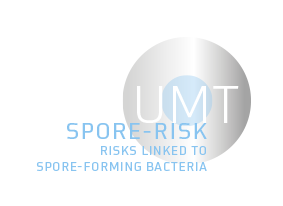
Coordination
Partners
Objectives
Predictive microbiology and risk analysis have become indispensable ways of anticipating the risks related to the possible presence of pathogenic bacteria and spoilage bacteria in food and processes. The contamination levels of unwanted cultures, as well as the results of challenge-tests, are usually measured by cropping methods, which are known to potentially over-estimate dangers, and could be improved by including the bacterial stress resulting from the impact of the processes. It also means integrating the physiological status of the cell resulting from processing and environmental stress or revivification conditions, and thus the variability of behaviours of individual cells. Henceforth, one of the challenges is to correctly integrate all of these factors in predictive microbiology and risk analysis to improve accuracy.
The main objective of the ACTIA SPORE-RISK UMT is to integrate cellular history and develop knowledge regarding bacterial resistance mechanisms in order to anticipate bacterial behaviour and measure the health and spoilage risks in quantitative terms. To optimise inactivation stages during processes and more accurately determine shelf-lives that will help enhance the competitiveness of the food sector while avoiding an over-estimation of the dangers.
This UMT, located in Quimper, started its five-year programme in January 2014.
It follows on from the ACTIA PHYSI’OPT UMT.
Actions
The ACTIA SPORE-RISK UMT will enable the anticipation and modelling of the germination and inactivation of spore-forming cultures. These mechanisms will be studied at both population and individual cell levels. The case study model being the Bacillus cereus group, the concepts will be extended in order to prove their validity on a highly prevalent spoilage species, Bacillus licheniformis.
The scientific programme is organised around five sub-projects:
SP1: Biodiversity and diversity of behaviours
SP2: Cell history and biomarker quantification
SP3: Individual cell behaviour
SP4: "Barrier" effects and repercussions on microbial behaviour in risk management
SP5: Quality management support tools to guarantee the stability of processed products





